Text
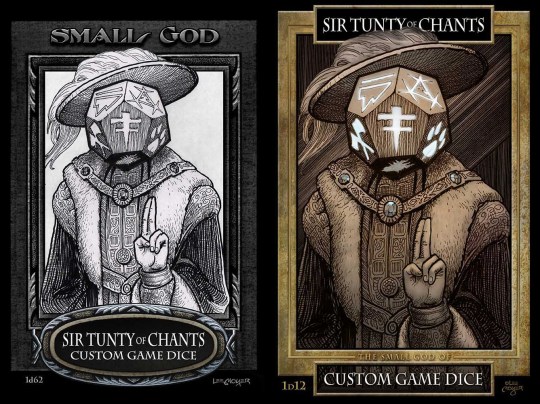
Sir Tunty is celebrating today! When Lee did his portrait back in the day, he modeled his face on the die he designed for 13th Age. And just as Sir Tunty has been upgraded, 13th Age's second massive edition is Kickstarting now, featuring loads of Lee's artwork. Link here:)
#lee moyer#rpg#13th age#jonathan tweet#rob heinsoo#aaron mcconnell#d&d#icons and stories#dieties#adventure#Pelgrane Press#Fire Opal
81 notes
·
View notes
Text
“Dustyn, why did you back the 13th Age 2e Kickstarter when you have a deep loathing for the d20 rule system?”
:) Because I am a shill for anything related to Pelgrane Press, and damn it, if I’m going to like a D20 game it’ll be their D20 game.
14 notes
·
View notes
Text
Help Me Pick My Next RPG Thing, Part 2!
Well, the most votes went to "More Pulp Cthulhu or related" so...
(I'm including all the various Call of Cthulhu stuff I bought in this category)
I may or may not have a third poll after this.
Edit: Gah, I forgot to put in a "Click Here To See Results" option, I'm so sorry!
I'm gonna randomly pick...Dreamlands.
#Random Thoughts#Poll#Pulp Cthulhu#Call of Cthulhu#Down Darker Trails#Regency Cthulhu#Terror Australis#Harlem Unbound#Cthulhu Confidential#Raiders of R'lyeh#Chaosium#Pelgrane Press#Berlin the Wicked City#Cthulhu Dark Ages#Reign of Terror#Horror on the Orient Express#Cthuhlu#Japan: Empire of Shadows#Children of Fear#Cthulhu By Gaslight#Cthulhu Through The Ages#Chtulhu#Roleplaying Games#RPGS#TTPGs#Cipher Bureau
12 notes
·
View notes
Text

My copy of Even Death Can Die, a collection of one-GM, one-player adventures for the CTHULHU CONFIDENTIAL TTRPG came! I love this game—I ran it over Zoom for a few friends during lockdown.
#cthullhu#cosmic horror#one gm one player#TTRPG#gumshoe#gumshoe one-2-one#pelgrane press#robin laws#Gareth Ryder-Hanrahan#Ruth Tillman#Chris Spivey#roleplaying game#tabletop rpg
2 notes
·
View notes
Photo
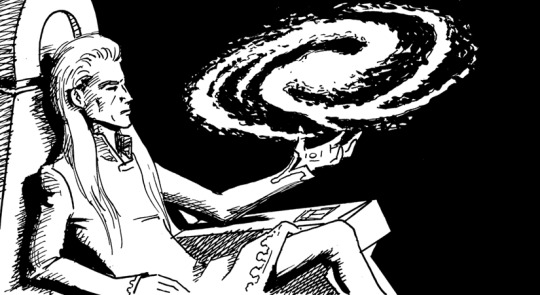
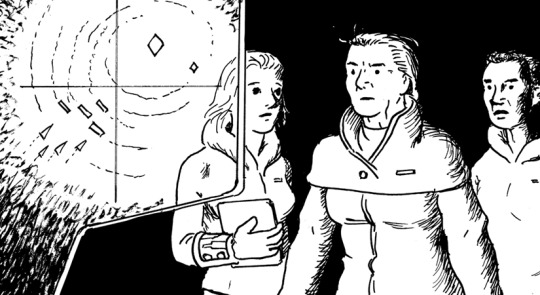
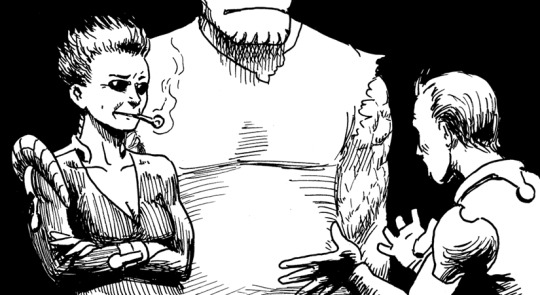
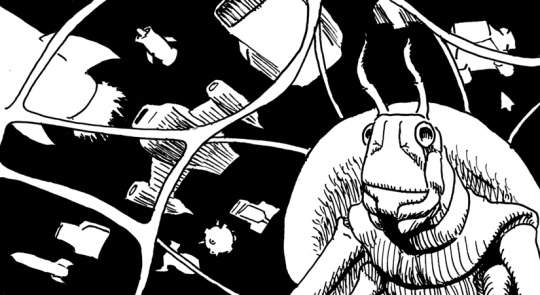
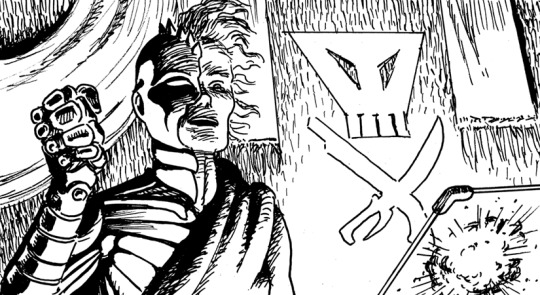

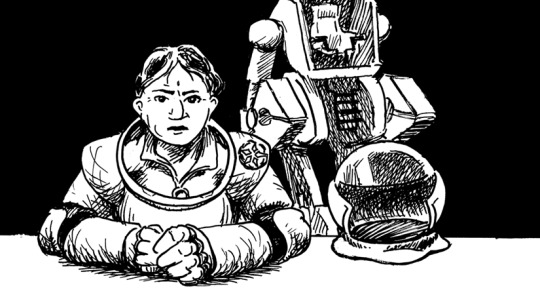
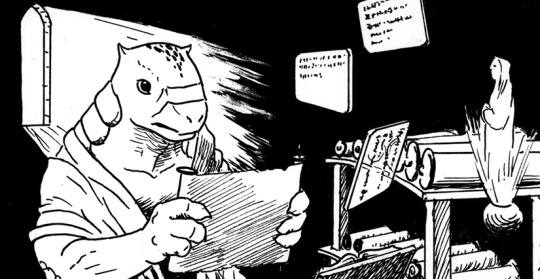
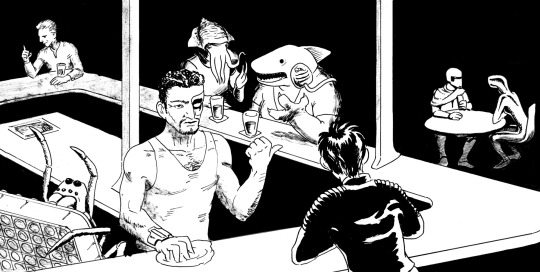
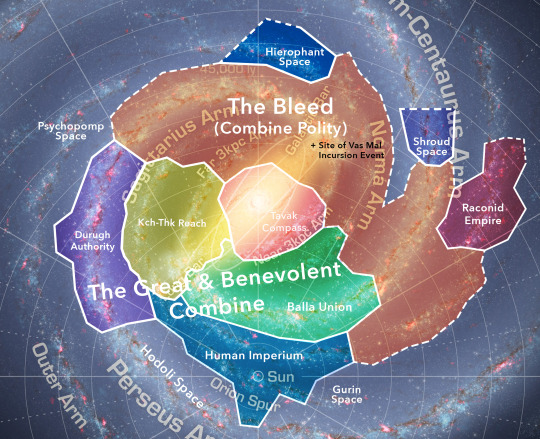

These are more illustrations that I did for Rogues’ Galaxy, my hack of Robin Laws’ amazing game Ashen Stars. The top b/w drawings are some of the 13 icons that I made, cribbing from 13th Age’s icons system. The color maps show the galaxy as a whole and the different regions in the Bleed. Laws liked to keep the Bleed abstract, but I found it helpful to know where in the galaxy I was going. I overlaid the sectors on a map of the Milky Way made by NASA.
It’s satisfying to be able to make a book all by yourself—write it, art direct it, illustrate it, make the maps, design the logo and headers, lay it out, and prep it for the printers—but it also highlights the areas where you're weak. I would love to find talented editors, designers, art directors and illustrators to help me with my next projects.
1 note
·
View note
Note
do you know of any ttrpgs where you play as a dragon rider? ideally that would be the main premise that the game is built around, but i'm open to anything that involves riding dragons.
THEME: Dragon Riders
Hello friend. For standalone games regarding Dragon Riders, I was only able to rustle up one. So to make up for it, I have some supplements for other games as suggestions, as well as a way of hacking a different genre to make it work for you.
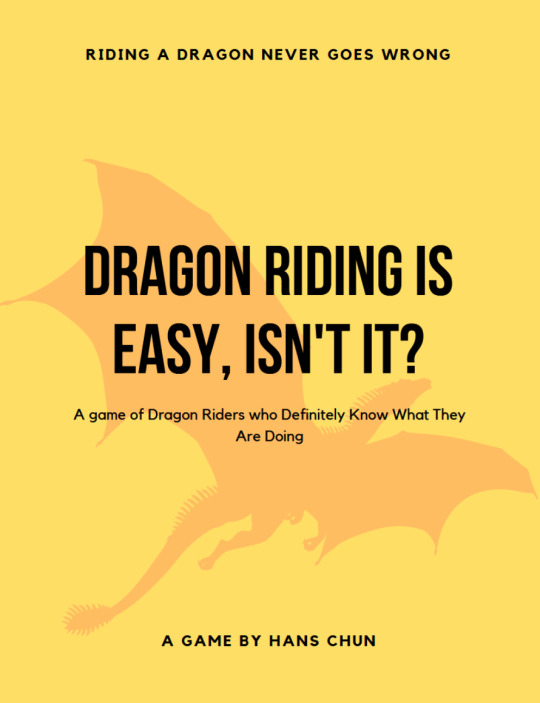

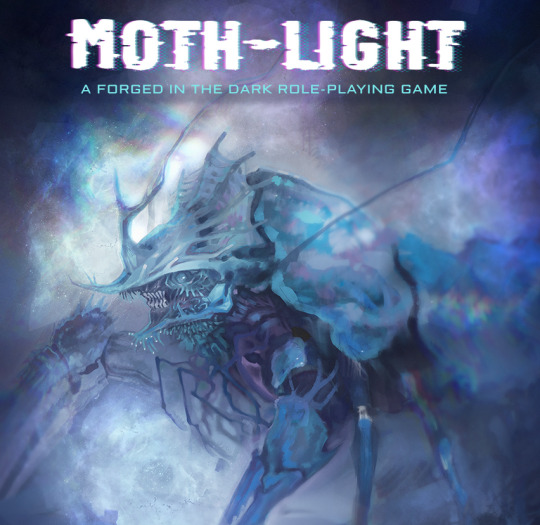


Dragon Riding is Easy, Isn’t It? By Hans.
You are a Dragon Rider. With your companion dragon and your friends, you will face danger, see the world, and make new friends. Along the way you will take turns playing the Rival, driving the story forward and confronting the Dragon Riders with their foes.
This is a game with a lot of room for decisions about what exactly you’re riding dragons for. Collaboratively, your group will decide what makes Dragon Riders stand out, and what kinds of differences exist between the dragons of your world. The dice system uses d6s, with staggered levels of success. What’s interesting about your dice results is that each one must be assigned to an aspect of the task at hand (Goals, Risks, Traits and Complications), which means that your results well tell you more than whether or not you simply succeeded or failed. The meat of the story will surround the efforts of the group to foil the plot of the Rival, a character played by members of the party who sit in the GM’s chair - and everyone might get a chance to take a turn at this! The system itself feels pretty rules light, and the game its pay-what-you-want, so it’s worth checking out!
Dragon Riding, (for 13th Age) by Pelgrane Press.
The lethal combination of dragon and rider helped create the Dragon Empire. Now unleash the fury on your foes! Full rules for player character dragon riders appear alongside story advice for campaigns looking to add dragon-riding options.
13th Age is a fantasy game built similarly to games like D&D 3.5 and D&D 4e, but containing mechanics that address the narrative side of play. Rather than focusing on a consistently “realistically” coherent setting, 13th Age focuses on what is dramatically important instead. Character creation will look similar in that it has races and classes, but you also decide on a relationship between your character and an Icon of the setting - the Icon being a major player in the world. This relationship makes your character immediately relevant to whatever story is about to happen, putting them front-and-centre of the action.
The Dragon Riding Supplement adds rules to the base game and advice on how to incorporate dragon riding into a story. You don’t just get character options - you also get adventures and advice on how dragon riding might be incorporated into battle, how the healing system works with dragons, and more.
If you are familiar with games like D&D and Pathfinder, then 13th Age isn’t a very big step. However, if you ‘re new to tabletop roleplaying games, this is a pretty big learning curve, so be prepared for a significant amount of rules and lore.
Moth-Light by Justin Ford and RIDERS by Me!
If you’d like a game that can easily turn into a game about Dragon Riding, you can also check out my RIDERS supplement for Moth-Light. The creatures of Moth-Light are supposed to be giant insect-like creatures called Moths, but I wrote RIDERS while being deeply inspired by the Chronicles of Pern - which is a science-fiction setting that has dragon riders!
Metal Sword, by Mousewife Games.
Metal Sword is an "acoustic cover" of Austin Ramsay's Beam Saber. It's a fully playable Forged in the Dark game, but with simpler rules, easy to read character sheets, and less overall math than is often seen in games of this genre.
The central mechanic for building both your pilot character and their vehicle are "Quirks", which you devise similar to how you would design your vehicle's Quirks in Beam Saber or a character's aspects in FATE.
Alright so you’re probably asking - why is there a mech game in this list of recommendations about dragon riders? I think there’s a lot of similarities between the kinds of stories told in mech games and the stories about dragon riders. You are a tiny, fragile human, responsible for a large, powerful creature or machine. Success in any mission requires a great level of knowledge and skill.
I chose Metal Sword because it’s a very stripped-down version of Beam Saber that is pretty easy to hack. The biggest change you’d have to make is the terminology. Your Vehicle becomes your Mount. Your Vehicle Actions become something like Heal, Maneuver, Sense and Blast. Because you are writing in the Quirks according to what makes you and your mount unique, you can incorporate details about your dragon’s powers and personality into character creation.
Not all Mech games will easily convert to Dragon Rider games. But I think there’s definitely potential!
181 notes
·
View notes
Text
The ORC Alliance Grows
meanwhile, at Paizo Blog (published January 19, 2023) :
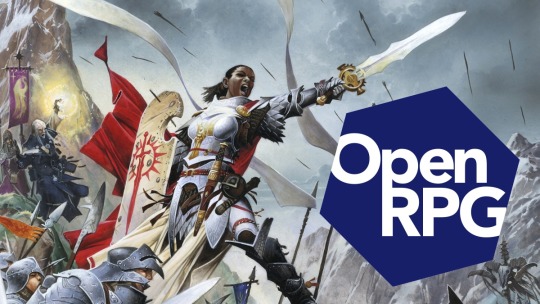
Over the course of the last week, more than 1,500 tabletop RPG publishers, from household names going back to the dawn of the hobby to single proprietors just starting out with their first digital release, have joined together to pledge their support for the development of a universal system-neutral open license that provides a legal “safe harbor” for sharing rules mechanics and encourages innovation and collaboration in the tabletop gaming space.
The alliance is gathered. Work has begun.
It would take too long to list all the companies behind the ORC license effort, but we thought you might be interested to see a few of the organizations already pledged toward this common goal. We are honored to be allied with them, as well as with the equally important participating publishers too numerous to list here. Each is crucial to the effort’s success. The list below is but a representative sample of participating publishers from a huge variety of market segments with a huge variety of perspectives. But we all agree on one thing.
We are all in this together.
Alchemy RPG
Arcane Minis
Atlas Games
Autarch
Azora Law
Black Book Editions
Bombshell Miniatures
BRW Games
Chaosium
Cze & Peku
Demiplane
DMDave
The DM Lair
Elderbrain
EN Publishing
Epic Miniatures
Evil Genius Games
Expeditious Retreat Press
Fantasy Grounds
Fat Dragon Games
Forgotten Adventures
Foundry VTT
Free RPG Day
Frog God Games
Gale Force 9
Game On Tabletop
Giochi Uniti
Goodman Games
Green Ronin
The Griffon’s Saddlebag
Iron GM Games
Know Direction
Kobold Press
Lazy Wolf Studios
Legendary Games
Lone Wolf Development
Loot Tavern
Louis Porter Jr. Designs
Mad Cartographer
Minotaur Games
Mongoose Publishing
MonkeyDM
Monte Cook Games
MT Black
Necromancer Games
Nord Games
Open Gaming, Inc.
Paizo Inc.
Paradigm Concepts
Pelgrane Press
Pinnacle Entertainment Group
Raging Swan Press
Rogue Games
Rogue Genius Games
Roll 20
Roll for Combat
Sly Flourish
Tom Cartos
Troll Lord Games
Ulisses Spiele
You will be hearing a lot more from us in the days to come.
[source]
375 notes
·
View notes
Text
Hello internet I would like your help!!
I’m currently compiling a list of as many pieces of media that contain references/allusions to the King in Yellow (either the fictional play or any interpretation of the character) as possible. This is my list so far, in no particular order, but if you’re aware of something I haven’t listed here, pls let me know !!
Malevolent (podcast)
Signalis (video game)
Fear and Hunger: Termina (video game)
Identity V (video game)
Vampire Survivors (video game)
True Detective (tv show) season 1
ADDITIONS:
SCP-701: the hanged king (collaborative fiction wiki)
Haiyore! Nyaruko-san (anime)
The Dark Tower series by Stephen King - The Crimson King (book series)
The Baby in Yellow (video game)
Sucker for Love (video game)
Persona 2 (video game)
Arkham Horror series by Fantasy Flight (card games)
Deltra Green (RPG system)
Call of Cthulhu (RPG system)
The Yellow King from Pelgrane Press (RPG system)
The Call of the Void (podcast)
The Sinking City (video game)
World of Horror (video game)
Lovecraft’s Untold Stories (video game series)
Mass Effect - the planet Carcosa (video game)
#the king in yellow#malevolent#malevolent podcast#signalis#fear and hunger#funger#true detective#mine#….finally giving in to my desire to make an elaborate youtube video tracing the origin of tkiy#this bits just for fun it’s not important but it’s always funny to list lots of things v quickly
51 notes
·
View notes
Text
ArcDream Writing Delta Green: You are in a subdimension of Carcosa where Soviets and Nazis are locked in eternal combat. It's horrific and terrible and both sides are evil. They are both in Carcosa together, so really it's impossible to tell which side is worse. Also Bashar Al Assad is a worshipper of the Crawling Chaos and is just trying to disrupt the international rules based order. You need to need to work with Raytheon to stop them.
Pelgrane Press Writing Fall of Delta Green: Look I gotta level with you brother the empire demands blood. The unnatural is just another frontier to conquer. Someday soon they're going to pretend like they didn't ask us to drop napalm on that village so they can sleep soundly in their beds pretending like we were just a few bad apples, but we both know this is how the sausage gets made. So until that day, we have a lot of meat to grind and not a lot of time to do it so y'know. Have fun. Go apeshit. You might not get the chance tomorrow.
22 notes
·
View notes
Text
The 10 Most Anticipated TTRPGs For 2024!
EN World's annual vote on the most anticipated titles of the coming year, and yes, some games have appeared on this list in previous years.
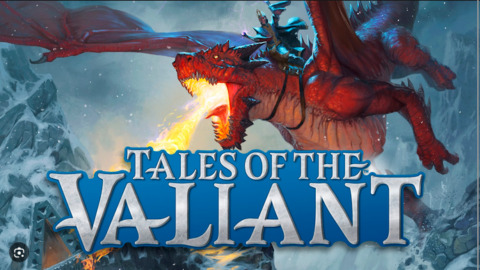
10 Tales of the Valiant (Kobold Press)
1st appearance Kobold Press joins the 'alternate 5E' club with this rewritten, non-OGL version of the game! A million dollar Kickstarter last year, and a new one for the GM's book going on right now, Kobold Press announced this as 'Project Black Flag' during the OGL crisis of 2023, but being unable to trademark that name opted for Tales of the Valiant instead. The system, however, is still called the Black Flag Roleplaying System.
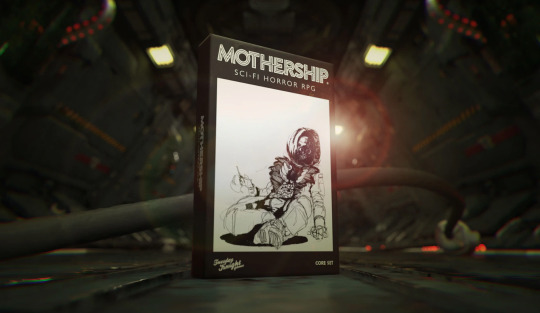
9. Mothership 1E (Tuesday Night Games)
3rd appearance On this list three years running, the boxed Mothership 1E game should be coming out this year! This is sci-fi horror at its best -- you can play scientists, teamsters, androids, and marines using the d100 'Panic Engine'. Yep, it's Alien(s), pretty much.
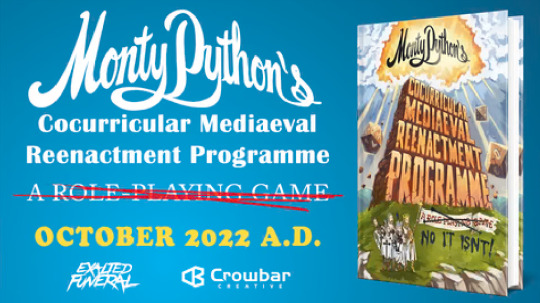
8. Monty Python's Cocurricular Mediaeval Reenactment Program (Exalted Funeral)
2nd Appearance Exalted Funeral made quite a splash when they announced this game last year, which went on to make neary $2M on Kickstarter. And how could they not? It's Monty Python fergoodnessake! A rules-lite gaming system, spam, a minigame with catapults, spam, coconut dice rollers, spam, and an irrepressible Python-eque sense of humour. Did I mention the spam? It was at #10 on this list last year, but it's claimed to #8 this year.

7. Daggerheart (Darrington Press)
1st appearance From the Critical Role folks, Daggerheart is a new fantasy TTRPG with its own original system coming out this year with "A fresh take on fantasy RPGs, designed for long-term campaign play and rich character progression."

6. Cohors Cthulhu (Modiphius)
1st appearance It's Ancient Rome. It's Cthulhu. It uses Modiphius' in-house 2d20 System. You can be a gladiator, a centurion, or a Germanic hero. Did I mention Cthulhu?
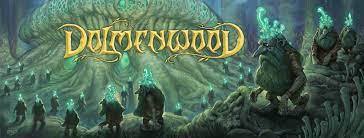
5. Dolmenwood (Necrotic Gnome)
1st appearance The British Isles, a ton of folklore, and a giant Kickstarter--Dolmenwood is a dark, whimsical fantasy TTRPG drawing from fairy tales and lets you "journey through tangled woods and mossy bowers, forage for magical mushrooms and herbs, discover rune-carved standing stones and hidden fairy roads, venture into fungal grottoes and forsaken ruins, battle oozing monstrosities, haggle with goblin merchants, and drink tea with fairies."
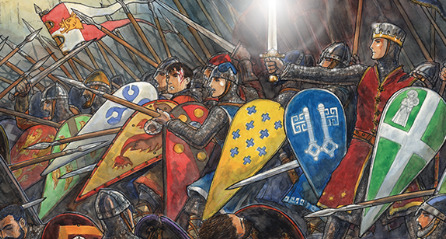
4. Pendragon 6E (Chaosium)
4th appearance Last year's winner was on this list waaaaay back in 425 AD, and it's still here! Well, maybe not that far back, but it's shown up in 2021 at #4, 2022 at #3, 2023 at #1, and now 2024 at #4! What can we say? People are clearly anticipating it... still.
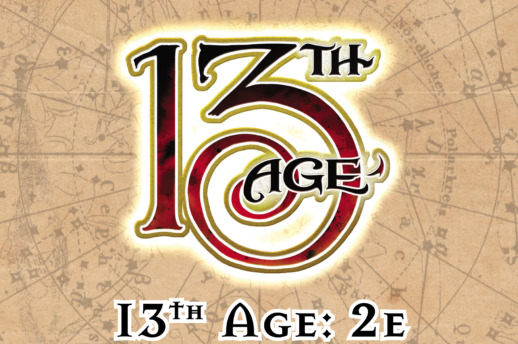
3. 13th Age 2nd Edition (Pelgrane Press)
2nd appearance 13th Age is over a decade old now, and was our most anticipated game way back in 2013. Now the new edition is coming! It's compatible with the original, but revised and with a ton more... stuff! 13th Age 2E was #3 in last year's list!

2. The Electric State Roleplaying Game (Free League)
1st appearance Free League is always on these lists, and for good reason. This gorgeous looking game is described as "A road trip on the verge of reality in visual artist and author Simon Stålenhag's vision of an apocalyptic alternate 1990s".

1. Shadow of the Weird Wizard (Schwalb Entertainment)
3rd appearance First announced by Rob Schwalb a couple of years ago, this is a more family-friendly version of his acclaimed RPG, Shadow of the Demon Lord. SHADOW OF THE WEIRD WIZARD is a fantasy roleplaying game in which you and your friends assume the roles of characters who explore the borderlands and make them safe for the refugees escaping the doom that has befallen the old country. Unsafe are these lands: the Weird Wizard released monsters to roam the countryside, cruel faeries haunt the shadows, undead drag themselves free from their tombs, and old, ancient evils stir once more. If the displaced people would rebuild their lives, they need heroes to protect them. Finally at the top of the list after being #7 in 2022, and #6 in 2023!
#RPG#Tales of the Valiant#Mothership#Monty Python#Daggerheart#Cohors Cthulhu#Dolmenwood#Pendragon#13th Age#The Electric State#Shadow of the Weird Wizard
28 notes
·
View notes
Quote
Lilly was a sort of Midwestern ideal type of the Lovecraftian protagonist: born in St. Paul to wealthy parents, he studied chemistry and philosophy from an early age. His undergraduate career at Caltech (1933-1938) almost exactly overlaps the period of the alchemist-Crowleyite John Whiteside Parsons’ GALCIT rocketry program there, and both were chemistry students. (Lilly and Parsons almost certainly met, Caltech not being that big a world in the Thirties, but what happened — or Happened — during that Trail of Cthulhu time slot has managed to go un-recorded in their various biographies.) He entered Dartmouth medical school in 1938, then transferred to Penn where he continued his Lovecraftian development by conducting various medical experiments on himself and writing a forbidden text: a book (this was 1942) called How To Build an Atomic Bomb. He conducted postgraduate work under pioneering biophysicist (and putative Majestic-12 member) Detlev Bronk and at the National Institute of Mental Health (NIMH), doing research for the Air Force — among other things developing early electro-encephalograms and, in 1954, the first sensory deprivation tank. According to his memoirs, he was approached by the CIA to work on such things as animal-activated surveillance and explosives, and (perhaps) on the MK-ULTRA mind-control project. According to Lilly, he refused, nobly insisting that his work remain open for all. He loudly resigned from NIMH in 1958. Having boldly proclaimed his independence from government control, Lilly founded the Communication Research Institute Inc. (CRII) on the island of St. Thomas in the U.S. Virgin Islands. CRII was, of course, funded by NASA, the U.S. military, and possibly other shadowy figures. Lilly had become interested in the question of dolphin brains: much like those of humans, cetacean brains are very large in ratio to their bodies and have an even higher density of neurons. Lilly set up dolphin tanks and pools, and began to experiment on dolphins, most notoriously when his dolphin Peter fell for researcher Margaret Lowe Howitt while she tried to teach Peter to speak English. It wasn’t all dolphin grabass in the islands, though: Lilly also dissected and probed the brains of the cetaceans, in between drug experiments (on them and himself) and attempts to decipher dolphin communication by floating next to them in sensory deprivation tanks. James Wade’s terrific 1969 short story “The Deep Ones” provides a fictionalized Lilly in the form of Miskatonic hippie guru Alonzo Waite, and in the form of his opposite number, dolphin researcher Dr. Frederick Wilhelm. Most impressively, it casts the dolphins as one more intermediary between man and Cthulhu, cousin or evolutionary stage of the Deep Ones. Wade mentions the ancient Greek myth that dolphins were pirates turned into beasts by Dionysos, tying it wonderfully into the deeper Mythos truths of Dagon and human-oceanic interbreeding of the Innsmouth sort. Any Fall of Delta Green Handler has a whole mini-campaign just lying there between Wade’s fictions and the CRII’s madness. But it doesn’t end there. Wade doesn’t even bring in Lilly’s involvement in SETI, which (likely again via NASA back channels) wound up connecting Lilly and the CRII with astrophysicist Frank Drake, who considered dolphins a template for alien life on Earth. Lilly presented his dolphin theories at the Green Bank astrophysics conference in 1961 where Drake coined his famous equation for the probability of alien life. He was such a hit that Drake, Lilly, a pre-turtleneck Carl Sagan, and biologist J.B.S. Haldane all made up the “Order of the Dolphin” and wore dolphin lapel pins when they were wearing lapels, which wasn’t often in St. Thomas.
Call of Chicago: John C. Lilly, One-Man Mythos – Pelgrane Press Ltd
10 notes
·
View notes
Text
The Axes of TTRPG Game Design
All the way back in Issue #69 of the Indie RPG Newsletter, I linked to a series of episodes from the Ken and Robin Talk About Stuff podcast about the “axes of game design”. I've been thinking about them again recently and thought it might be interesting to look at each one. I'll be referring to the summary on the Pelgrane Press blog as I comment on them.
So the basic exercise is trying to figure out the standard axes or spectrums on which every game can fit. The idea is for these axes to be as descriptive and objective as possible. While there is always going to be debate around the classification of specific games, the idea is that in a perfect world with perfect communication, that debate would have a truly correct answer. We don’t live in a perfect world but I'm happy to discuss things like this forever.
So here we go:
Elegance versus Ornamentation
"A game has Elegance if all of its subsystems work in the same way, stemming from a central resolution mechanic, or is Ornamented if its many subsystems work in different ways"
So the first axis is one of the strongest and makes a great example of the level of objectivity we can hope to achieve here. In some sense, the degree to which a game falls back on a single unified mechanic should be clear and measurable. At the same time, it’s not any indication of how “good” a game is. One-page games are highly elegant but they’re by no means “better” than longer games.

One thing that's interesting is to see where PbtA falls on this spectrum. A game like Monster of the Week is pretty elegant because everything is essentially 2d6+stat. But does the number of moves, especially moves like Big Magic where you negotiate the effects of a spell or ritual, push it toward being more ornamentated?
2. Wide versus Focused
"A game has Width if it supports play equally well over a long progression of power levels, or Focus if it works best at a narrower sweet spot."
I think this is where it’s probably best to start moving away from Hite and Laws’ wording. I think terms like “power level” is a wargame hangover. I think this is better phrased as “kinds of characters”. A game that is Wide is designed for a many kinds of characters. A game that is Focused is designed for specific characters or types of characters.

So you get something like Lady Blackbird (which has a cast of named characters on one side) as Focused and Risus (which is as generic as it gets in terms of character creation) as Wide. And yes, I put D&D 5e in there because I revel in the symphony of a hundred angry keyboards click-clacking away.
3. Directed Emotion versus Emergent Emotion
"A game can have Directed Emotion, stemming from rules that lead you to feel a certain way, or Emergent Emotion, in which the reactions of players and GMs stem from the story content they introduce."
This phrasing is a little clunky because in their discussion, Hite and Laws felt that something like “Emotional versus Detached” was uncharitable. And I understand. But I also think that “Directed versus Emergent” is a bit like saying “Designed versus Undesigned”. I think the premise of the exercise that is “undesigned” isn’t a thing. If we want to describe a game as “neutral” on some axes, it should ideally fall somewhere in the middle. So I propose Hot versus Cool. Hot games try to stoke up emotions in the players. Cool games try to cultivate an air of cool, ironic detachment. They don’t want you to feel too strongly about the events of the game.

(The original article also mentions “Abstract rules for their mathematical or formal attributes, or Emotional rules when they grow out of the feelings they are meant to evoke at the table.” but this feels like it overlaps heavily with this point now.)
4. Applicability versus Versatility
"A game has high Applicability if it is designed for a single highly specific player character core activity, or Versatility if it supports many possible core activities."
This is just Wide versus Focused for mechanics rather than characters. On one hand, they’re separate things. On the other hand, it’s clearly related. It’s a bit hard to imagine how a game might support wide characters with focused mechanics or focused characters but with wide mechanics, right?
5. Simulation versus Emulation
"Games that focus on Simulation resolve events as they would unfold in a causal reality, or engage in Emulation, so that events unfold as they would in a movie or book, to keep the narrative running in a satisfying manner."
I’m not quite sure about this one. I’m struggling to understand which games commit to simulating real world physics. What’s the game on that end of the spectrum? I know OSR games revolve around the GM arbitrating physics impartially but in a game where dragons exist, how seriously do I take that claim? They would probably be in the middle of this axis at best if you ask me.
6. Ease versus Mastery
"A game favors Ease when players can pick it up and run with it right away, or Mastery if it presents complex or elaborate rules or setting material, favoring those who take the time and brainspace to learn it."
For me, the important thing to ask ourselves here is whether the word “player” includes GMs. If it does, all rules-light games that might seen to favour Ease are not so easy anymore. (Which reminds me that I never actually talked about “affordances” as a design concept - an article for another day.) If we limit ourselves to “player facing mechanics”, then yes, I can see the spectrum. The problem is, of course, it looks exactly like my Elegant versus Ornamented spectrum.

What kind of games are Ornamented but don’t reward Mastery? What kind of games are Elegant but don’t favour Ease?
(The original article also uses a "Harmonica vs Violin" axis with Harmonicas being simple to play and Violins requiring more work. I think the overlap here is high.)
7. Canon versus Open
"When it comes to setting, a game oriented around Canon presents a detailed setting with a set continuity meant to instill the same suspension of disbelief we apply to SF and fantasy worlds in traditional media. Open settings arise from the authorship of GM and/or players, with plenty of room to make stuff up as you go along."
This seems really clear. And I think examples might be unnecessary.
8. Randomness versus Choice
"A game or system dependent on Randomness uses die results to work out what happens. A game that privileges Choice has players and GMs decide."
This also seems clear. Some games don’t give players the power to just choose what happens next. Some games push players to decide when they want spend resources to just make a specific thing happen.

Okay, so does that all check out?
64 notes
·
View notes
Text
Hey, all! Just learned Trail of Cthulhu by Pelgranepress is getting a 2nd edition! Updated and made a bit more fresh for ease of use, with a lot of best practices worked into the game after years and years of Gumshoe play. I’ll always be attached to Gumshoe as a system, having play tested for a number of games and scenarios to come out for it over the years, and I really can’t recommend it enough!
If you’ve never heard of Trail of Cthulhu or Gumshoe, the core premise of the system is to never have a moment in-game where investigators can’t move forward in an investigation because they failed a information gathering test. In Gumshoe players always gather core clues. The fun comes from how they use those clues, and the horrors they unlock as they delve deeper into darker corners of a world they thought they knew!
If you want to give it a look, sign up for their newsletter on Backerkit! They give you a quick start PDF with a fun scenario about mysterious figures being sighted around a crashed ship.
#ttrpg#tabletop roleplaying#roleplaying games#rpgs#trail of Cthulhu#Cthulhu mythos#investigative roleplay#roleplay#roleplaying#horror rpg#horror roleplay
3 notes
·
View notes
Note
Every Cthulhu game EXCEPT CoC, yes. So, thoughts on Fate of Cthulhu?
Okay so, rating from 1 to 10, 5 being "as fun as CoC", and considering i actually like playing CoC in spite of everything:
Delta green: I like modern settings and most of the rule changes, except for combat. Fuck the US though. Also I called the co-creator a pervert on twitter. 5/10.
Trail of cthulhu: Cool concept with enough crap to make every side of ttrpg mad. Pelgrane press loves AI art now. 5/10.
Cthulhu dark (paid edition): A setting guide with a ruleset to make trail look like pathfinder. insight instead of (in)sanity. insight is Still pretty much sanity. 5/10.
Pulp Cthulhu: It's not enough to live under Hairy Longcraft's racist shadow, one must rise to the occasion and become Doc Savage. 5/10.
Fate of cthulhu: it's FATE, of Cthulhu. it's messy, but kinda fun. No (in)sanity but corruption. Yet losing humanity makes you a monster, and monsters are the irredeemable bad guys. it's FATE. 5/10.
Achtung! cthulhu: 3 or more versions for different systems. All of which make no sense to me, i don't even like the setting. Maybe killing nazis will let us forget about Harry polyp longcraft. 3/10.
Cthulhutech: 2000s japanophilia-infused dice-pool system D&D with cthulhu stuff. Humans are being replaced with aliens! But also the human government is bad (but not racist, just anti-alien)! South America is there! Madness is reversible! Some of the worst misogynistic shit I've read in a game! It's a mess that should be researched for the sake of humanity, lest us repeat our history. Also, it's probably an evil artifact that possessed catalyst game labs. 1/10.
Arkham Horror: boardgame fun 6/10. Eldritch Horror: Arkham horror but better 7/10. Mansions of Madness: Betrayal at house on the hill but with cthulhu and you need a phone. 4/10. Elder sign: worse arkham horror 4/10. Cthulhu death may die: miniatures 4/10. Every chaosium book for other ages of history: idk 5/10. Munchkin cthulhu: NO 2/10.
13 notes
·
View notes
Text
Updaterino
I do apologize for being gone for quite a while actually I'm working on this big ol' King in Yellow themed artwork (with my half-oc half interpretation of Hastur ofc, lmao), setting up a campaign centered around Pelgrane Press's Yellow King rpg, and got an oc commission to work on for a friend. Can you tell that I like the King in Yellow lol I'll probably chuck out some fan art next week; I'm in such a mood for cosmic horror that I might make content for games like Shadows over Loathing, Dredge, even Lethal Company (it counts! Pyrocynical said so in his funni lore video!!1) No spoilers on what exactly I'll make though, that's the fun part :)
So uh stay tuned!
2 notes
·
View notes
Photo
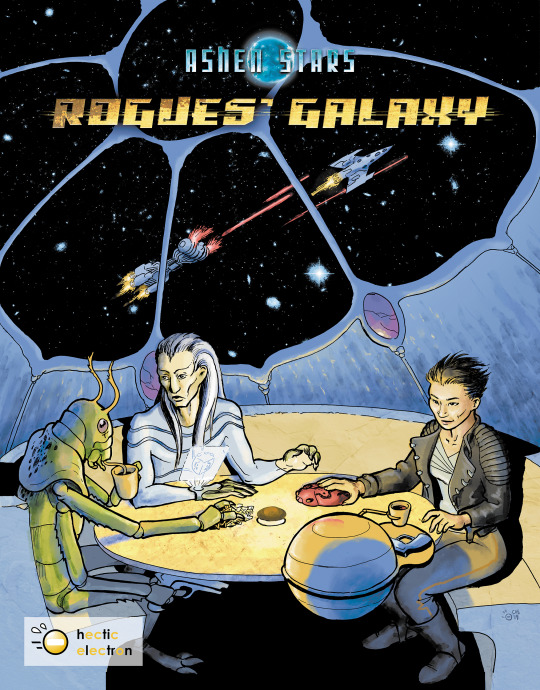
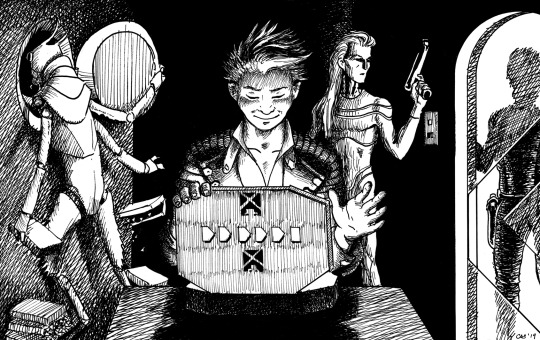
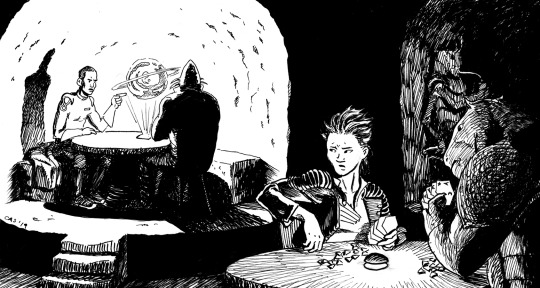
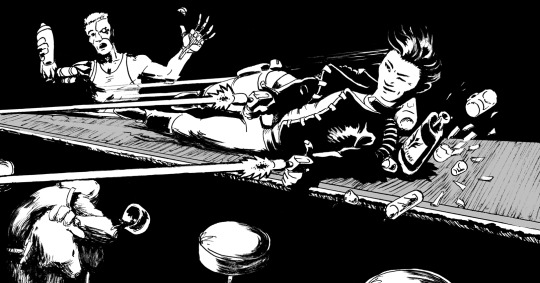
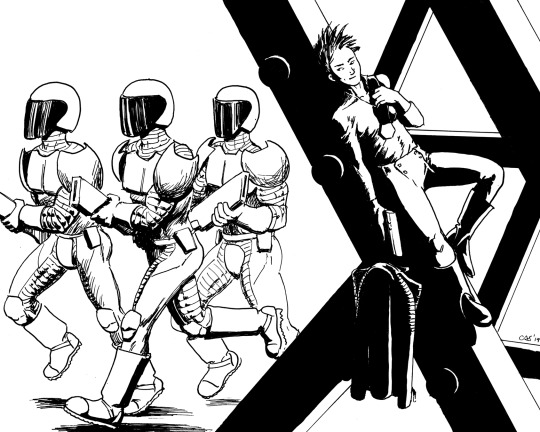

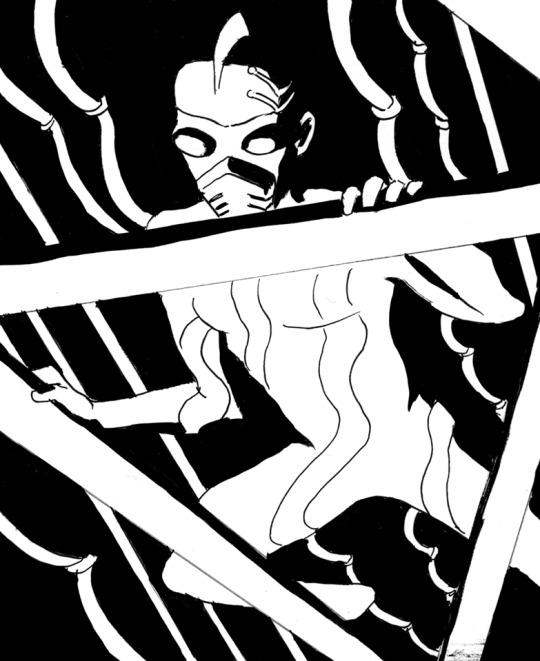
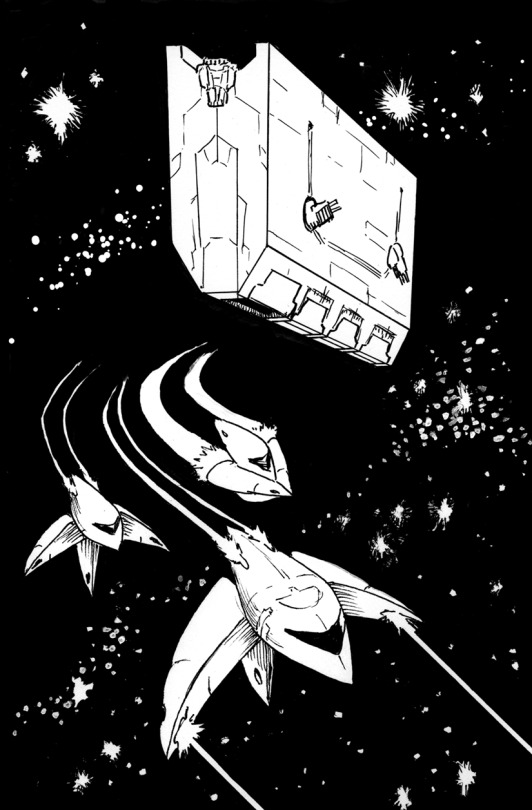

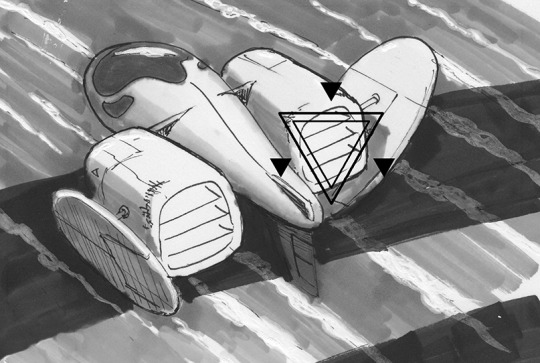
These are some illustrations I did for Rogues’ Galaxy. It’s a hackbook that I wrote for Pelgrane Press’s Ashen Stars, which I adore. In the original game, you play a crew of freelance investigators, solving mysteries and fighting crime. It’s an amazing, fun game that can play at a breathtaking scale. In Rogues’ Galaxy, you play crooks trying to get by and uncovering mysteries in the process.
0 notes